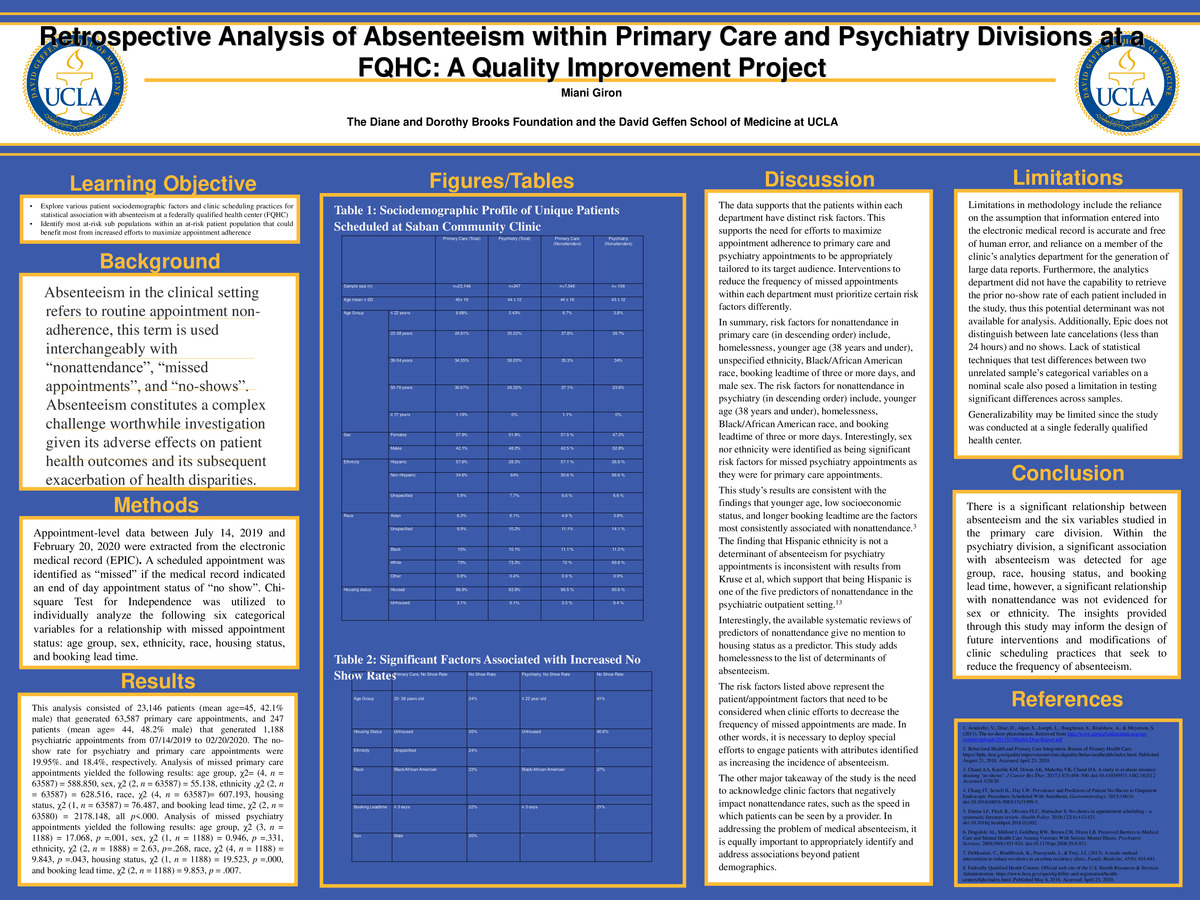-
Author
Miani Giron -
Co-author
-
Title
Retrospective Analysis of Absenteeism within Primary Care and Psychiatry Divisions at a FQHC: A Quality Improvement Project
-
Abstract
Background: Absenteeism in the clinical setting refers to routine appointment non-adherence. Absenteeism constitutes a complex challenge given its adverse effects on patient health outcomes and its subsequent exacerbation of health disparities. This retrospective chart review study compared absenteeism in primary care versus psychiatry divisions at a federally qualified health center (FQHC) by patient sociodemographic factors and clinic scheduling practices.
Methods: Appointment and patient-level data between July 14, 2019 and February 20, 2020 were extracted from the electronic medical record. An appointment was identified as “missed” if the medical record indicated an end of day appointment status of “no show.” Chi-square Test for Independence was utilized to analyze the following six variables for a relationship with missed appointment status: age group, sex, ethnicity, race, housing status, and booking lead time.
Results: This analysis consisted of 23,146 patients (mean age=45, 42.1% male) that generated 63,587 primary care appointments, and 247 patients (mean age= 44, 48.2% male) that generated 1,188 psychiatric appointments from July 2019 to February 2020. The no-show rates for psychiatry and primary care appointments were 19.95%. and 18.4%, respectively. Analysis of missed primary care appointments yielded the following results: age group, χ2= (4, n = 63587) = 588.850, sex, χ2 (2, n = 63587) = 55.138, ethnicity ,χ2 (2, n = 63587) = 628.516, race, χ2 (4, n = 63587)= 607.193, housing status, χ2 (1, n = 63587) = 76.487, and booking lead time, χ2 (2, n = 63580) = 2178.148, all p<.000. Analysis of missed psychiatry appointments yielded the following results: age group, χ2 (3, n = 1188) = 17.068, p =.001, sex, χ2 (1, n = 1188) = 0.946, p =.331, ethnicity, χ2 (2, n = 1888) = 2.63, p=.268, race, χ2 (4, n = 1188) = 9.843, p =.043, housing status, χ2 (1, n = 1188) = 19.523, p =.000, and booking lead time, χ2 (2, n = 1188) = 9.853, p = .007.
Conclusion: There is a significant relationship between absenteeism and the six variables studied in the primary care division. Within the psychiatry division, a significant association with absenteeism was detected for age group, race, housing status, and booking lead time, however, a significant relationship with nonattendance was not evidenced for sex or ethnicity. These findings support existing literature showing that to address the problem of absenteeism, programs must adapt clinic-level practices to provide additional supports to specific vulnerable patient populations. These insights will support ongoing FQHC quality improvement efforts, with future mixed-methods evaluations identifying more granular clinic-level adaptations to improve attendance at appointments and eradicate inequities in absenteeism. This study was supported by the Diane and Dorothy Brooks Foundation and the David Geffen School of Medicine at UCLA.
-
College
AAC
-
Zoom
-
PDF

